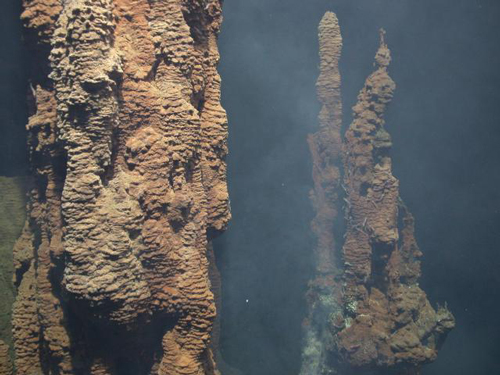Source: Earth’s Future
Buildings, infrastructure, mobile phones, batteries, and electric cars contain valuable metals such as copper, zinc, silver, and gold. With the seemingly insatiable demand for products enabled by these materials, new sources are needed, particularly as land-based reserves become scarce or are located in places that are too difficult, dangerous, or costly to access.

These metals exist, however, in mineral deposits on rocky submarine mountains, on abyssal plains, at mid-oceanic ridges, and around underwater hydrothermal vents. For example, it has been suggested that nodules of manganese found in places such as the Clarion-Clipperton zone, an extensive area on the Pacific Ocean floor, could satisfy current demand for decades.
Beaulieu et al. reflect on a session at the 2017 American Association for the Advancement of Science annual meeting that posed the question, Should we mine the seafloor? As scientists, they wanted to approach the question with objective, scientific evidence.
The question is not without controversy. Although some people see the oceans as the last untapped resource on Earth, others see them as a precious natural asset to be protected.
The authors note that exploitation of the shallow seafloor already takes place, with the dredging of sand and gravel and extraction of tin, gold, and diamonds from shallow reserves. Technology also enables the oil and gas industry to operate on seabeds up to 3 kilometers below the surface.
It is not yet possible to mine reserves that lie deeper, but the authors point out that it may become a reality. As of mid-2017, 27 licenses for exploration have been granted by the International Seabed Authority, a United Nations body established in 1984 with responsibility for regulating deep seabed mining.
The main thrust of discussion explores whether deep seafloor mining is economically feasible, technologically possible, environmentally appropriate, ecologically sustainable, and legally manageable. However, the authors’ attempt to make an objective assessment was limited because this topic is mired in so many uncertainties.
Because little is known about the quantity and quality of resources in existence, the resources may not even be worth exploiting. No one yet knows whether extraction from the ocean could be competitive with land-based mining.
Technological uncertainties also abound. For example, will equipment work effectively in the extreme environment of the deep oceans? Although technologies to map and mine these resources have developed significantly, much further testing remains.
And perhaps most important, not enough is known about the ecological implications of deep seafloor mining. Deep-sea environments aren’t well studied, and even less is known about the vulnerability or resilience of marine ecosystems to such interference.
But the authors see a key opportunity: Unlike most other forms of natural resource exploitation in human history to date, scientists could work with lawyers to put a legal framework in place before large-scale exploitation starts, thereby ensuring a responsible and regulated approach. There are developments to this end; for example, the International Seabed Authority is currently working with scientists on a first draft of environmental regulations for mining in areas beyond national jurisdictions.
However, with a lack of accurate scientific information and so many economic, technological, and environmental uncertainties, is it even possible to create effective environmental regulations? To this end, the researchers suggest that when exploration and testing contracts are granted, those executing the contracts not only survey potential resources and try new technologies but also use the opportunity to study ecosystem responses and provide valuable data to researchers. They also call for a transdisciplinary approach, drawing on the expertise of researchers from across different fields in the physical and social sciences to inform such international agreements.
Recent years have seen a shift from speculation to limited exploration of the deep seafloor, but at some point, the authors stress, resource exploitation will become a reality. (Earth’s Future, https://doi.org/10.1002/2017EF000605, 2017)
—Jenny Lunn, Contributing Writer
Citation:
Lunn, J. (2017), Natural resource exploitation could reach new depths, Eos, 98, https://doi.org/10.1029/2017EO078297. Published on 21 July 2017.
Text © 2017. The authors. CC BY-NC-ND 3.0
Except where otherwise noted, images are subject to copyright. Any reuse without express permission from the copyright owner is prohibited.

